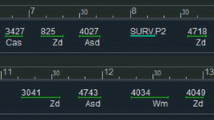Abstract
The Royal Australian Navy's Patrol Boat Force carries out essential tasks in the surveillance, policing and defence of Australia's coastal waters. To help the Navy make efficient use of a new generation of boats, the authors have developed optimization procedures to schedule the activities of the boats and their crews. The procedures—embodied in a software system called CBM (‘Crews, Boats, Missions’)—use simulated annealing and specialized heuristic techniques within a multi-stage problem-solving framework. Tests show that CBM is reliable in terms of solution quality, and flexible with respect to the range of scheduling conditions applied. CBM has proved valuable to the Navy as an investigatory tool, and it is planned that it should be adapted for operational use, as part of a decision support system to aid in the ongoing management of patrol boat operations.
Similar content being viewed by others
References
Cordeau J-F, Stojković G, Soumis F and Desrosiers J (2001). Benders decomposition for simultaneous aircraft routing and crew scheduling. Transport Sci 35(4): 375–388.
CPLEX (2001). ILOG CPLEX Version 7.0 User's Manual. ILOG CPLEX: Gentilly.
Dowsland KA (1993). Simulated annealing. In: Reeves C.R. (Ed). Modern Heuristic Techniques for Combinatorial Problems. Wiley: New Yorkpp. 20–69.
Ernst AT, Jiang H, Krishnamoorthy M and Sier D (2004). Staff scheduling and rostering: A review of applications, methods and models. Eur J Opl Res 153(1): 3–27.
Freling R, Huisman D and Wagelmans APM (2003). Models and algorithms for integration of vehicle and crew scheduling. J Scheduling 6(1): 63–85.
Haase K, Desaulniers G and Desrosiers J (2001). Simultaneous vehicle and crew scheduling in urban mass transit systems. Transport Sci 35(3): 286–303.
Horn MET, Jiang H and Kilby PJ (2003). Scheduling the Australian Patrol Boat Force. CSIRO Mathematical and Information Sciences Technical Report, CMIS 03/169.
van Laarhoven PJM and Aarts EHL (1987). Simulated Annealing: Theory and Application. Reidel: Dordrecht.
Acknowledgements
Commander Gerry Kelly of the Royal Australian Navy, and Dr Ping Cao of the Australian Defence Science and Technology Organization, were sponsors of the project discussed in this paper. We thank them for their support and encouragement.
Author information
Authors and Affiliations
Corresponding author
Rights and permissions
About this article
Cite this article
Horn, M., Jiang, H. & Kilby, P. Scheduling patrol boats and crews for the Royal Australian Navy. J Oper Res Soc 58, 1284–1293 (2007). https://doi.org/10.1057/palgrave.jors.2602300
Received:
Accepted:
Published:
Issue Date:
DOI: https://doi.org/10.1057/palgrave.jors.2602300




